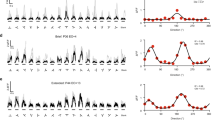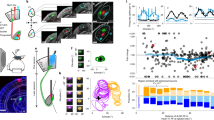Abstract
Most models of thalamocortical development in the visual system assume a homogeneous population of thalamic inputs to the cortex, each with concentric on- or off-center receptive fields. To test this, we made high-resolution spatial maps of receptive fields in the developing ferret lateral geniculate nucleus (LGN). Developing receptive fields (RFs), had a variety of shapes: some concentric, others elongated (like adult cortical receptive fields) and some with ‘hot spots’ of sensitivity. These receptive fields seemed to arise from convergence of multiple retinal afferents onto LGN neurons. We present a Hebbian model whereby imprecise retinogeniculate connections help refine geniculocortical connections, sharpening both thalamocortical topography and perhaps orientation selectivity.
This is a preview of subscription content, access via your institution
Access options
Subscribe to this journal
Receive 12 print issues and online access
$209.00 per year
only $17.42 per issue
Buy this article
- Purchase on Springer Link
- Instant access to full article PDF
Prices may be subject to local taxes which are calculated during checkout








Similar content being viewed by others
References
Wiesel, T. N. & Hubel, D. H. Single-cell responses in striate cortex of kittens deprived of vision in one eye. J. Neurophysiol. 26, 1003–1017 (1963).
Rakic, P. Prenatal genesis of connections subserving ocular dominance in the rhesus monkey. Nature 261, 467–471 (1976).
LeVay, S., Stryker, M. P. & Shatz, C. J. Ocular dominance columns and their development in layer IV of the cat's visual cortex: a quantitative study. J. Comp. Neurol. 179, 223–244 (1978).
Stryker, M. P. & Harris, W. A. Binocular impulse blockade prevents the formation of ocular dominance columns in cat visual cortex. J. Neurosci. 6, 2117–2133 (1986).
Katz, L. C. & Shatz, C. J. Synaptic activity and the construction of cortical circuits. Science 274, 1133–1138 (1996).
Miller, K. D. A model for the development of simple cell receptive fields and the ordered arrangement of orientation columns through activity-dependent competition between ON- and OFF-center inputs. J. Neurosci. 14, 409–441 (1994).
Galli, L. & Maffei, L. Spontaneous impulse activity of rat retinal ganglion cells in prenatal life. Science 242, 90–91 (1988).
Meister, M., Wong, R. O., Baylor, D. A. & Shatz, C. J. Synchronous bursts of action potentials in ganglion cells of the developing mammalian retina. Science 252, 939–943 (1991).
Artola, A. & Singer, W. Long-term potentiation and NMDA receptors in rat visual cortex. Nature 330, 649–652 (1987).
Bear, M. F., Kleinschmidt, A., Gu, Q. A. & Singer, W. Disruption of experience-dependent synaptic modifications in striate cortex by infusion of an NMDA receptor antagonist. J. Neurosci. 10, 909–925 (1990).
Mooney, R., Penn, A. A., Gallego, R. & Shatz, C. J. Thalamic relay of spontaneous retinal activity prior to vision. Neuron 17, 863–874 (1996).
Bienenstock, E. L., Cooper, L. N. & Munro, P. W. Theory for the development of neuron selectivity: orientation specificity and binocular interaction in visual cortex. J. Neurosci. 2, 32–48 (1982).
Von der Malsburg, C. & Cowan, J. D. Outline of a theory for the ontogenesis of iso-orientation domains in visual cortex. Biol. Cybern. 45, 49–56 (1982).
Daniels, J. D., Pettigrew, J. D. & Norman, J. L. Development of single-neuron responses in kitten's lateral geniculate nucleus. J. Neurophysiol. 41, 1373–1393 (1978).
Blakemore, C. & Vital-Durand, F. Organization and post-natal development of the monkey's lateral geniculate nucleus. J. Physiol. (Lond.) 380, 453–491 (1986).
Mason, C. A. Development of terminal arbors of retino-geniculate axons in the kitten—I. Light microscopical observations. Neuroscience 7, 541–559 (1982).
Sur, M., Weller, R. E. & Sherman, S. M. Development of X- and Y-cell retinogeniculate terminations in kittens. Nature 310, 246–249 (1984).
Sretavan, D. W. & Shatz, C. J. Prenatal development of retinal ganglion cell axons: segregation into eye-specific layers within the cat's lateral geniculate nucleus. J. Neurosci. 6, 234–251 (1986).
Tootle, J. S. & Friedlander, M. J. Postnatal development of the spatial contrast sensitivity of X- and Y-cells in the kitten retinogeniculate pathway. J. Neurosci. 9, 1325–1340 (1989).
Barlow, H. B. & Pettigrew, J. D. Lack of specificity of neurones in the visual cortex of young kittens. J. Physiol. (Lond.) 218, 98–100 (1971).
Albus, K. & Wolf, W. Early post-natal development of neuronal function in the kitten's visual cortex: a laminar analysis. J. Physiol. (Lond.) 348, 153–185 (1984).
Chapman, B. & Stryker, M. P. Development of orientation selectivity in ferret visual cortex and effects of deprivation. J. Neurosci. 13, 5251–5262 (1993).
Chapman, B., Stryker, M. P. & Bonhoeffer, T. Development of orientation preference maps in ferret primary visual cortex. J. Neurosci. 16, 6443–6453 (1996).
Gödecke, I., Kim, D. S., Bonhoeffer, T. & Singer, W. Development of orientation preference maps in area 18 of kitten visual cortex. Eur. J. Neurosci. 9, 1754–1762 (1997).
Issa, N. P., Trachtenberg, J. T., Chapman, B., Zahs, K. R. & Stryker, M. P. The critical period for ocular dominance plasticity in the ferret's visual cortex. J. Neurosci. 19, 6965–6978 (1999).
Reid, R. C., Victor, J. D. & Shapley, R. M. The use of m-sequences in the analysis of visual neurons: linear receptive field properties. Vis. Neurosci. 14, 1015–1027 (1997).
Hubel, D. H. & Wiesel, T. N. Integrative action in the cat's lateral geniculate body. J. Physiol. (Lond.) 155, 385–398 (1961).
Vidyasagar, T. R. & Urbas, J. V. Orientation sensitivity of cat LGN neurones with and without inputs from visual cortical areas 17 and 18. Exp. Brain Res. 46, 157–169 (1982).
Soodak, R. E., Shapley, R. M. & Kaplan, E. Linear mechanism of orientation tuning in the retina and lateral geniculate nucleus of the cat. J. Neurophysiol. 58, 267–275 (1987).
Cleland, B. G., Dubin, M. W. & Levick, W. R. Simultaneous recording of input and output of lateral geniculate neurones. Nat. New Biol. 231, 191–192 (1971).
Usrey, W. M., Reppas, J. B. & Reid, R. C. Specificity and strength of retinogeniculate connections. J. Neurophysiol. 82, 3527–3540 (1999).
Hammond, P. Cat retinal ganglion cells: size and shape of receptive field centres. J. Physiol. (Lond.) 242, 99–118 (1974).
Cai, D., DeAngelis, G. C. & Freeman, R. D. Spatiotemporal receptive field organization in the lateral geniculate nucleus of cats and kittens. J. Neurophysiol. 78, 1045–1061 (1997).
Murphy, P. C. & Sillito, A. M. Corticofugal feedback influences the generation of length tuning in the visual pathway. Nature 329, 727–729 (1987).
Sherman, S. M. & Guillery, R. W. On the actions that one nerve cell can have on another: distinguishing “drivers” from “modulators”. Proc. Natl. Acad. Sci. USA 95, 7121–7126 (1998).
Hamos, J. E., Van Horn, S. C., Raczkowski, D., Uhlrich, D. J. & Sherman, S. M. Synaptic connectivity of a local circuit neurone in lateral geniculate nucleus of the cat. Nature 317, 618–621 (1985).
Alonso, J. M., Usrey, W. M. & Reid, R. C. Precisely correlated firing in cells of the lateral geniculate nucleus. Nature 383, 815–819 (1996).
Usrey, W. M., Reppas, J. B. & Reid, R. C. Paired-spike interactions and synaptic efficacy of retinal inputs to the thalamus. Nature 396, 384–387 (1998).
Cleland, B. G. in Visual Neuroscience (eds. Pettigrew, J. D., Sanderson, K. S. & Levick, W. R.) 111–120 (Cambridge Univ. Press, London, 1986).
Mastronarde, D. N. Interactions between ganglion cells in cat retina. J. Neurophysiol. 49, 350–365 (1983).
Henderson, Z., Finlay, B. L. & Wikler, K. C. Development of ganglion cell topography in ferret retina. J. Neurosci. 8, 1194–1205 (1988).
Linden, D. C., Guillery, R. W. & Cucchiaro, J. The dorsal lateral geniculate nucleus of the normal ferret and its postnatal development. J. Comp. Neurol. 203, 189–211 (1981).
Peters, A. & Payne, B. R. Numerical relationships between geniculocortical afferents and pyramidal cell modules in cat primary visual cortex. Cereb. Cortex 3, 69–78 (1993).
Peichl, L. & Wässle, H. Size, scatter and coverage of ganglion cell receptive field centres in the cat retina. J. Physiol. (Lond.) 291, 117–141 (1979).
Kirkwood, A., Lee, H. K. & Bear, M. F. Co-regulation of long-term potentiation and experience-dependent synaptic plasticity in visual cortex by age and experience. Nature 375, 328–331 (1995).
Reid, R. C. & Alonso, J. M. Specificity of monosynaptic connections from thalamus to visual cortex. Nature 378, 281–284 (1995).
Crowley, J. C. & Katz, L. C. Development of ocular dominance columns in the absence of retinal input. Nat. Neurosci. 2, 1125–1130 (1999).
Sherk, H. & Stryker, M. P. Quantitative study of cortical orientation selectivity in visually inexperienced kitten. J. Neurophysiol. 39, 63–70 (1976).
Zahs, K. R. & Stryker, M. P. The projection of the visual field onto the lateral geniculate nucleus of the ferret. J. Comp. Neurol. 241, 210–224 (1985).
Price, D. J. & Morgan, J. E. Spatial properties of neurones in the lateral geniculate nucleus of the pigmented ferret. Exp. Brain Res. 68, 28–36 (1987).
Acknowledgements
This work was supported by NIH grants EY10115 and EY12196, The Lefler Fund and the Quan Foundation. W. Martin Usrey and John Reppas provided assistance at all stages of this project. Sergey Yurgenson provided programming assistance, and Elisabeth Serra and Christine Couture, technical assistance. Markus Meister, Kenneth Miller, John Assad, Saeed Tavazoie, Ben Gewurz and Vamsi Mootha gave comments on previous versions of this manuscript.
Author information
Authors and Affiliations
Corresponding author
Rights and permissions
About this article
Cite this article
Tavazoie, S., Clay Reid, R. Diverse receptive fields in the lateral geniculate nucleus during thalamocortical development. Nat Neurosci 3, 608–616 (2000). https://doi.org/10.1038/75786
Received:
Accepted:
Issue Date:
DOI: https://doi.org/10.1038/75786
This article is cited by
-
The times they are a-changin’: a proposal on how brain flexibility goes beyond the obvious to include the concepts of “upward” and “downward” to neuroplasticity
Molecular Psychiatry (2023)
-
Face detection in untrained deep neural networks
Nature Communications (2021)
-
Activity-dependent disruption of intersublaminar spaces and ABAKAN expression does not impact functional on and off organization in the ferret retinogeniculate system
Neural Development (2011)
-
Retinal origin of orientation maps in visual cortex
Nature Neuroscience (2011)
-
Experience with moving visual stimuli drives the early development of cortical direction selectivity
Nature (2008)



